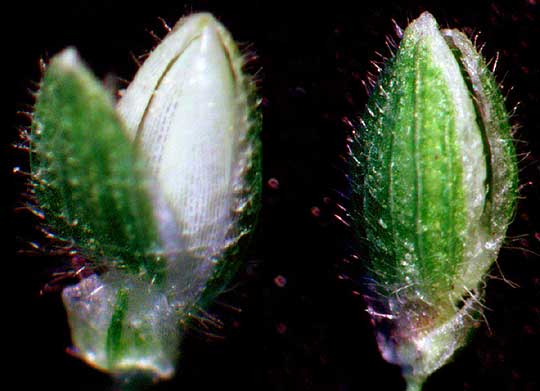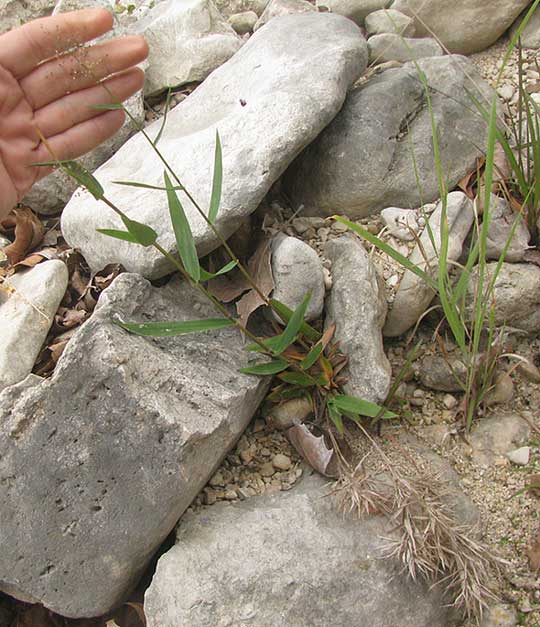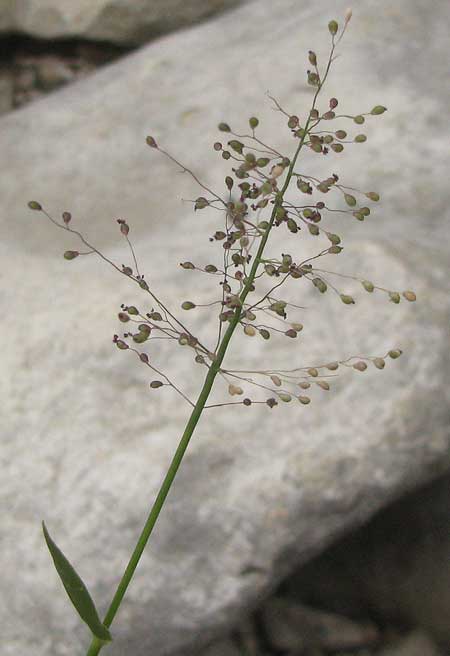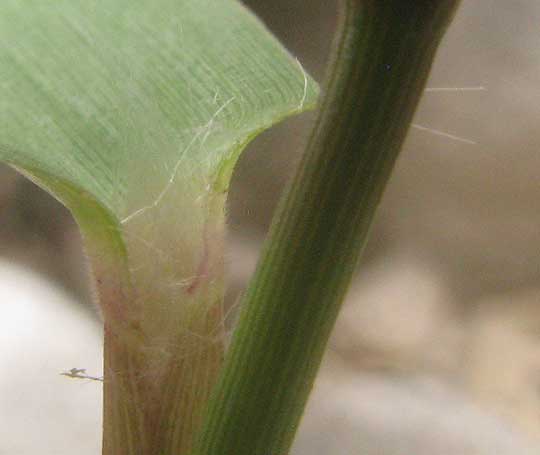Excerpts from Jim Conrad's
Naturalist Newsletter

from the November 10, 2013 Newsletter issued from the Frio Canyon Nature Education Center in the valley of the Dry Frio River in northern Uvalde County, southwestern Texas, on the southern border of the Edwards Plateau; elevation ~1750m (~5750 ft); N29.62°, W99.86°; USA
WESTERN PANICGRASS
Above you see a handsome little ankle-high grass thriving in a hint of soil accumulated among limestone rocks at the edge of a bank just above the Dry Frio River. Note the well formed rosette of broad leaves at the plant's base, which next spring will issue fresh new inflorescences, and the robustly branched stems bearing smaller, slenderer leaves than those at the base, plus notice the small clusters of flowers sprinkled here and there among the upper branches. Those flowers are unusually small, only about 1/16th-inch long
(1.4mm), and their small size and hairiness are good field marks. Below, you can see a close-up view of both the front and back of a flower:

Back in the old days any decent, first-year Local Flora student would have recognized this as a member of a huge grass genus with over 600 species, the genus Panicum. Panicums were referred to as panicgrasses because their inflorescences were of the much-branched panicle type. In my home county in Kentucky I identified twelve Panicum taxa. In fact, on a hot summer morning on Knob Hill near Cypress Creek, on August 1, 1969, I collected the very species shown above, designating it as Panicum lanuginosum.
However, since those days genetic sequencing has come along and the big, easy-to-recognize and easy-to-remember genus Panicum has been split to pieces. Among other changes, most species forming basal rosettes like those in our picture have been shifted to the fanciful-sounding genus Dichanthelium. Some experts point out that the genus Panicum is mostly tropical American, and in the tropics there's no clear distinction between Panicum and Dichanthelium, and I'm of their party, but I seem to share the minority view here.
The splitters also have changed the species name of the plant I first identified in Kentucky, so now our plant is known by most experts as DICHANTHELIUM ACUMINATUM. Reflecting the fact that it's so widely spread and taxonomically has been kicked about so much, the grass goes by several common names, including Tapered Witchgrass, Tapered Rosette Grass, Hairy Panicgrass, Hairy Rosette-panicgrass, Western Witchgrass, Western Panicum and Western Panicgrass. That last one strikes me as the most useful, so that's what I'll call it.
Besides producing overwintering basal rosettes, members of the genus Dichanthelium usually metabolize by the C3 carbon-fixation process -- considered a more primitive, less efficient pathway than the more recently evolved C4 route -- plus they flower both in spring and fall. In the fall they tend to produce "cleistogamous" flowers, in which the flower buds remain closed and thus self-pollinate. Our flower close-ups, then, are of cleistogamous fall flowers, which may explain why they are so small, even for this small-flowered species.
Western Panicgrass produces tiny grains much relished by small, seed-eating birds.
from the May 25, 2014 Newsletter issued from the Frio Canyon Nature Education Center in the valley of the Dry Frio River in northern Uvalde County, southwestern Texas, on the southern border of the Edwards Plateau; elevation ~1750m (~5750 ft); N29.62°, W99.86°; USA
WESTERN PANICGRASS IN SPRING
Nowadays our Western Panicgrasses are flowering again, but in spring they look very different than they did last fall. The airborne leaf tufts so conspicuous back then now have withered, died and collapsed, but in their place panicles of flowers are held aloft, as seen below:

In that picture, notice last fall's dead, bleached leafy tufts sprawled on the ground in the picture's lower, right corner. A close-up of the classic panicle-type inflorescence is shown below:

Western Panicgrass is famous for being very variable, especially in terms of hairiness, so for serious identifiers who eventually will read these words, a look at its ligule area at the base of a leaf is shown making clear this particular plant's philosophy of hairiness below:

Western Panicgrass is one of the most widespread, commonly occurring panicgrasses in North America, appearing coast to coast, from Canada south through the US, Mexico and Central America, into northern South America, varying prodigiously as it goes.